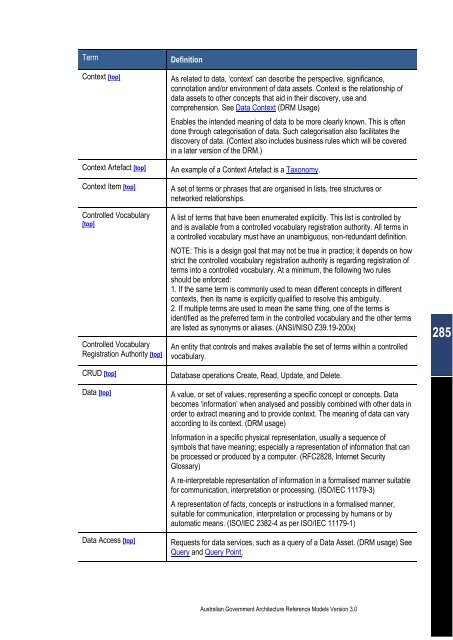Australian Government Architecture Reference Models Version 3.0
Australian Government Architecture Reference Models Version 3.0
Australian Government Architecture Reference Models Version 3.0
Create successful ePaper yourself
Turn your PDF publications into a flip-book with our unique Google optimized e-Paper software.
Term Definition<br />
Context [top] As related to data, ‘context’ can describe the perspective, significance,<br />
connotation and/or environment of data assets. Context is the relationship of<br />
data assets to other concepts that aid in their discovery, use and<br />
comprehension. See Data Context (DRM Usage)<br />
Enables the intended meaning of data to be more clearly known. This is often<br />
done through categorisation of data. Such categorisation also facilitates the<br />
discovery of data. (Context also includes business rules which will be covered<br />
in a later version of the DRM.)<br />
Context Artefact [top] An example of a Context Artefact is a Taxonomy.<br />
Context Item [top] A set of terms or phrases that are organised in lists, tree structures or<br />
networked relationships.<br />
Controlled Vocabulary<br />
[top]<br />
Controlled Vocabulary<br />
Registration Authority [top]<br />
A list of terms that have been enumerated explicitly. This list is controlled by<br />
and is available from a controlled vocabulary registration authority. All terms in<br />
a controlled vocabulary must have an unambiguous, non-redundant definition.<br />
NOTE: This is a design goal that may not be true in practice; it depends on how<br />
strict the controlled vocabulary registration authority is regarding registration of<br />
terms into a controlled vocabulary. At a minimum, the following two rules<br />
should be enforced:<br />
1. If the same term is commonly used to mean different concepts in different<br />
contexts, then its name is explicitly qualified to resolve this ambiguity.<br />
2. If multiple terms are used to mean the same thing, one of the terms is<br />
identified as the preferred term in the controlled vocabulary and the other terms<br />
are listed as synonyms or aliases. (ANSI/NISO Z39.19-200x)<br />
An entity that controls and makes available the set of terms within a controlled<br />
vocabulary.<br />
CRUD [top] Database operations Create, Read, Update, and Delete.<br />
Data [top] A value, or set of values, representing a specific concept or concepts. Data<br />
becomes ‘information’ when analysed and possibly combined with other data in<br />
order to extract meaning and to provide context. The meaning of data can vary<br />
according to its context. (DRM usage)<br />
Information in a specific physical representation, usually a sequence of<br />
symbols that have meaning; especially a representation of information that can<br />
be processed or produced by a computer. (RFC2828, Internet Security<br />
Glossary)<br />
A re-interpretable representation of information in a formalised manner suitable<br />
for communication, interpretation or processing. (ISO/IEC 11179-3)<br />
A representation of facts, concepts or instructions in a formalised manner,<br />
suitable for communication, interpretation or processing by humans or by<br />
automatic means. (ISO/IEC 2382-4 as per ISO/IEC 11179-1)<br />
Data Access [top] Requests for data services, such as a query of a Data Asset. (DRM usage) See<br />
Query and Query Point.<br />
<strong>Australian</strong> <strong>Government</strong> <strong>Architecture</strong> <strong>Reference</strong> <strong>Models</strong> <strong>Version</strong> <strong>3.0</strong><br />
285

















